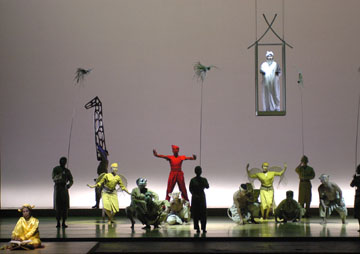|

verything about Robert Wilson's music-theater work I La Galigo is arresting. As the transparent scrim with a projected page written in Buginese characters rises on July 15, 2005, at the New York State Theater of Lincoln Center, Puang Matoa Saidi, a real life, practicing Bissu priest in a bright yellow robe settles at the front edge of the stage to sit and read from the Indonesian epic poem Sureq Galigo, a sacred text written between the 13th and 15th centuries. As if setting the standard for how one must behave in this demanding theater experience, the priest remains seated on stage for the three-hour, intermission-less play. Musicians led by Rahayu Supanggah, the composer of the original music for this work, also sit to one side for the duration of the performance.
Time nearly stops or is reset to another measure as an unhurried parade of players migrates across the stage carrying vessels and spears. Performers encased like snakes with long tails of fabric inch their way across the stage. In this way, the fifty plus players, all Indonesian, outline the boundaries of this magical universe that embraces the Upper and Under Worlds of the gods and also the Middle World of ordinary creatures and semi-divine offspring of the gods.
American filmmaker and writer Rhoda Grauer adapted a portion of the more than 6,000 page epic to include the beginning and end as well as characters and stories loved by the South Sulawei people. I La Galigo centers on divine twins who are sexually attracted to each other. When Sawérigading is born, Wilson has the boy slowly descend upside down from a ladder that stretches from ceiling to stage floor. Because he is born in warrior clothes, he is sent to sea where he has adventures like the Greek Odysseus and pretty soon, failing to capture the woman spirit of his desires, learns about his beautiful sister. Wé Tenriabéng, the female twin destined to be a Bissu priest has been brought up in secret. When her brother Sawérigading finds her, she tells him that he must seek the hand of their cousin who is Wé Tenriabéng's exact double. She also predicts that they will be reunited through their children with other spouses. However, the cousin lives far away over treacherous seas and Sawérigading needs a sturdy ship. With much ritual, a sacred tree is cut down disturbing all the wildlife of the forest. As Sawérigading begins his travel to find the cousin look-alike, Wé Tenriabéng ascends in a heavenly booth to become a ruler of the Upper World.

Perhaps one could have ended Wilson's I La Galigo piece at this juncture but the story continues with the complications of winning the cousin who has gotten erroneous information that Sawérigading is a barbarian. Her sources see Sawérigading's outrageous cousins who behave like Commedia dell'Arte clowns. After Sawérigading kills her family's soldiers, the cousin agrees to marry him if he brings back to life the fallen and if he agrees that she will never receive him in the light of day. She conceives, bears and rejects their son who is rescued by Sawérigading. Years later alone and lonely, she reunites with her son and husband after she sees them and wants to know who these magnificent people are. The closing scene involves the union of the twins' children just as Wé Tenriabéng prophesied. But because this is also a story of an entire universe, the lens widens and the narrator tells us that the gates to the Upper and Lower Worlds have slammed shut and what is left is a godless Middle World.
As in Wilson's productions of Four Saints in Three Acts and Black Rider, the audience sees the visual artist at work. Images are striking in unexpected ways that linger on the retina long after the image has left the stage. How bodies move demands close attention. Take the players all in bare feet and then see them step heel first until the curled up toes descend slowly and deliberately down on the ground. What looks and sounds interesting repeats in trance-inducing regularity until a viewer feels viscerally excited in the way tent preachers might induce a congregant to get up and testify. It is in this mood one can understand such poetic turns of phrase as "We swear by the skin of our throats."
What Wilson has created with I La Galigo is probably not reproducible except in some entirely different conception. What is remarkable about this particular production is that he has gathered an entire Indonesian population on one stage complete with a rare Bissu priest who actually can read the epic poem in the original Buginese language. Wilson also shows us the composer of the music, a music that takes its inspiration from traditional music of the South Sulawesi people. How often does a composer become a player in a show for which he has composed the music? As to the other players, they are deeply connected to the subject matter and they know how to move in ways that are appropriate to the mood and traditions of this piece. Probably the oddity is that the work does not present like a folklorique show for tourists.
|